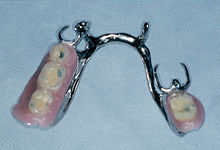Resilience (dentistry)

In dentistry, resilience is the flexibility of the oral mucosa when exposed to stress. Depending on its texture and thickness, the oral mucosa has different resilience. Local resilience of up to 3 mm can be observed in the glandular and fatty tissue zone in the upper jaw , whereas in the median fibrous zone of the palate , the torus palatinus , only fractions of a millimeter are observed . Among the researchers into resilience was the Turkish dentist Lem'i Belger, who was also trained in Germany.
Static resilience
If the load is sustained for several seconds, the static resilience is about 0.3 mm, with an area of 6 cm² and an applied force of 50 Newtons.
Dynamic resilience
With alternating stress and relief during the act of chewing, the dynamic resilience is around 0.1 mm with the same force and area, but with a shorter duration of stress.
Clinical significance
A tooth is suspended in its alveolus (tooth socket) on the Sharpey fibers , which allow the tooth to be slightly indented. This is about 10 times smaller than that of the oral mucosa. In the case of a partial denture that is supported both on the teeth and on the mucous membrane, this difference in resilience leads to a tipping load on the supporting teeth . The longer the prosthetic saddle resting on the mucous membrane, the greater the tilting load due to the longer lever .
The torus palatinus , an exostosis (bony bulge) in the middle of the so-called hard palate, can make it more difficult to hold a full denture in the upper jaw, as the surrounding mucous membrane is flexible, but the torus palatinus is not. Therefore, the prosthesis can rock right and left over the torus. This can be remedied by “relieving” the torus. For this purpose, a tin foil about 1 to 2 mm thick is placed on the plaster model over the area of the torus as a placeholder during the manufacture of the prosthesis , whereby the torus will be hollow in the finished prosthesis. When the chewing pressure is exerted, the surrounding mucous membrane gives way before the prosthesis comes into contact with the torus.
A cover denture corresponds to a full denture in which there are still a few remaining teeth in the dentition, which are provided with telescopic crowns (or root caps ). These are double crowns, the primary crown of which is firmly cemented onto the tooth, while the secondary crown is incorporated into the denture. The resilience telescope is a special form of the telescope crown. For an overdenture, double crowns have an incorporated resilience margin. The parallel-walled parts of the crowns ensure a defined alignment of the prosthesis, but the teeth are only loaded axially (in the direction of the roots) when the maxillary and oral mucosa has yielded to the maximum under the pressure of the prosthesis.
Dental significance
Implants show no resilience to natural teeth, they are rigidly connected to the bone and they lack any sensitive affinity. Chewing forces act unbuffered on the superstructure. The result is the highest fracture rates of ceramic on implants. In order to reduce this, hybrid materials have been developed that combine the advantages of the two material classes ceramic and plastic to form a new material in order to overcome the respective disadvantages and to simulate the resilience of natural teeth.
See also
- Resilience test according to Gerber
Individual evidence
- ^ Rudolf W. Ott: Clinic and Practice Guide Dentistry . Georg Thieme Verlag, 2003, ISBN 978-3-13-131781-0 , p. 494.
- ↑ Lem'i Belger: elasticity of the palatal mucosa (resilience). Dissertation 1947.
- ↑ Ali Vicdani Doyum: Alfred Kantorowicz with special reference to his work in İstanbul (A contribution to the history of modern dentistry). Medical dissertation, Würzburg 1985, pp. 227-232 and more often.
- ↑ Hans H. Caesar: The training as a dental technician. Neuer Merkur, Munich 1996, ISBN 3-929360-01-2 , p. 90.
- ^ Ernst-Jürgen Richter: Implant prosthetics. Overdenture. In: Wolfgang Gernet, Reiner Biffar, Norbert Schwenzer, Michael Ehrenfeld (eds.): Dental prosthetics. 4th, unchanged edition. Thieme, Stuttgart a. a. 2011, ISBN 978-3-13-593604-8 , pp. 84–131, here p. 117, ( limited preview on Google Books ).
- ↑ Gerwin Arnetzl, New Materials - New Perspectives , Zahntechnik Magazin, Spitta-Verlag , February 18, 2015. Accessed November 1, 2017.


